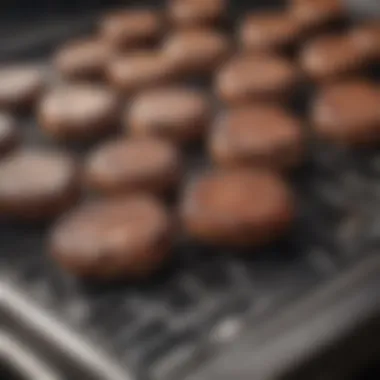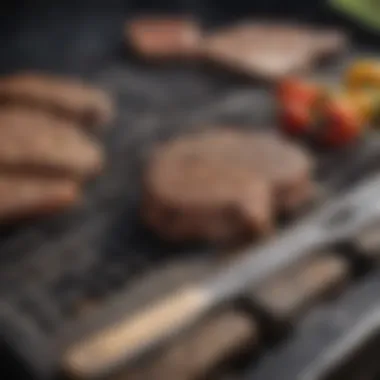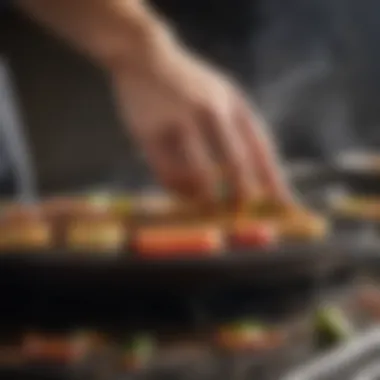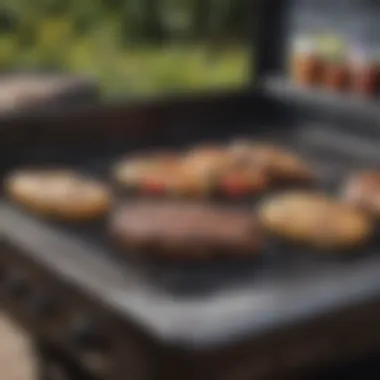Spotless Grill Cleaning: Expert Techniques Unveiled


Intro
Maintaining a spotless grill is vital for any culinary enthusiast. A clean grill not only enhances the flavor but also ensures safety during the cooking process. Grease and remnants from previous meals can harbor bacteria and affect the taste of fresh dishes. This article provides a thorough examination of the practices that contribute to a pristine grilling surface, focusing on effective cleaning techniques and preventive maintenance.
Proper grill cleaning is more than a chore; it is an art that reflects the dedication of the cook. As grilling techniques evolve, so too do the tools and methods we use to keep our grills in top condition. From charcoal to gas, each type of grill has unique cleaning requirements that deserve attention.
In the sections to follow, expect to find useful insights and detailed instructions that cater to various grilling styles. Whether you are a weekend griller or someone who hosts culinary gatherings year-round, understanding the significance of a clean grill is paramount to elevating your grilling experience.
Intro to Grill Cleaning
Cleaning a grill is not just a matter of aesthetics; it goes deeper into the realms of hygiene, safety, and food quality. A spotless grill creates the foundation for perfect barbecues and gatherings where food not only tastes better but also inspires confidence in those consuming it. Therefore, understanding the significance of grill cleaning is vital for anyone who enjoys cooking outdoors. This segment introduces several key benefits and best practices associated with maintaining a clean grill.
Importance of a Clean Grill
A clean grill serves multiple important functions. Firstly, it promotes health. Residues left on the grill can harbor harmful bacteria that might contaminate food. Grime from previous cookouts is a breeding ground for pathogens, which can compromise food safety.
Secondly, a clean grill contributes to better cooking results. Greased, charred surfaces affect the flavor and quality of grilled food. When a grill is clean, the heat distribution is uniform, ensuring that food is cooked evenly and retains its intended flavors.
In addition, a clean grill is easier to maintain over the long term. Routine cleaning prevents rust and corrosion, ultimately protecting your investment in the grilling appliance. A simple scrubbing can extend the lifespan of various components, saving you from unforeseen costs associated with replacements.
Consequences of Neglect
Failing to clean a grill can lead to several adverse effects. The most immediate consequence is the growth of bacteria and mold, increasing the risk of foodborne illnesses. When you grill meat or vegetables on a dirty surface, you could transfer harmful pathogens to your food.
Moreover, neglected grills often experience worsening performance. Residual food particles can block gas vents or electric lines, causing uneven heating and cooking. This inconsistency can lead to undercooked meals, which is particularly hazardous when grilling meats.
Neglecting cleaning duties can also lead to increased maintenance cost. The buildup of grease and grime can lead to more significant repair issues down the line. Cleaning a grill is not merely a chore; it is an essential step in ensuring optimal performance and longevity, underscoring the necessity of routine attention to your grilling equipment.
Types of Grills and Their Specific Cleaning Needs
Understanding the different types of grills is crucial for achieving effective cleaning. Each grill type comes with its unique construction and cooking methods, which translates to varying cleaning needs. Recognizing these needs ensures that grill owners can maintain hygiene and performance. This section will explore three main types of grills: Gas, Charcoal, and Electric, and detail the specific cleaning methods suitable for each.
Gas Grills
Cleaning gas grills requires attention to both the burners and grates to ensure optimal performance.
Burner Maintenance
Burner maintenance is a key component of cleaning gas grills. Clean burners allow for even heat distribution, which is vital for quality cooking. A common method involves using a wire brush to clear out debris and ensure no blockages.
A key characteristic of effective burner maintenance is the frequency. Regularly checking and cleaning the burners can prevent flare-ups and uneven cooking. This maintenance is popular because it enhances the efficiency of the grill. One unique feature of burner maintenance is its ability to prolong the lifespan of the grill itself by avoiding damage from accumulated grease or food particles. However, neglecting this can lead to costly repairs.
Grate Cleaning Techniques
Grate cleaning techniques are essential for maintaining a clean cooking surface in gas grills. Cleaning these grates properly prevents flavors from previous meals from transferring to new dishes. For this, using a high-quality grill brush or scraping tool after each use can be beneficial.
The versatility of grate cleaning techniques, such as using vinegar or other solutions, makes it a popular choice among grill enthusiasts. These methods not only improve hygiene but also enhance the overall flavor of grilled foods. The disadvantage, however, is that aggressive cleaning might damage the grate if not done carefully, especially if it is made of delicate materials.
Charcoal Grills
Charcoal grills present their own challenges, primarily due to ash buildup. Maintaining these grills enhances not just safety but also the overall grilling experience.
Removing Ash Residue
Removing ash residue is a critical task for owners of charcoal grills. Ash buildup can restrict airflow, leading to substandard cooking conditions. Using an ash vacuum or a simple metal shovel can make this process straightforward, ensuring the grill remains functional.
The key characteristic here is effectiveness. A clean grill can maintain better heat without interruptions. This cleaning method is essential because neglect can lead to excessive smoke and an unpleasant cooking experience. A potential downside is that waiting until the grill is completely cool is necessary to avoid burns, which can delay subsequent cooking sessions.
Scrubbing Grates Effectively
Scrubbing grates effectively is another important aspect of maintaining a charcoal grill. Charcoal tends to leave a sticky residue that requires diligent scrubbing to remove. A combination of heat and steam generated from water can help loosen stubborn grime.
This technique's key characteristic is the use of a wire brush, which allows for thorough cleaning while preserving the integrity of the grates. It is popular among charcoal users as it ensures every piece of food cooked on the grill has a fresh start. However, care must be taken, as overly aggressive scrubbing can scratch or damage the surface of the grates.


Electric Grills
Electric grills offer ease of use but still require proper cleaning methods to function optimally and ensure longevity.
Disassembling Components
Disassembling components is essential for precise cleaning. Electric grills comprise various parts, like plates and drip trays, that often require individual attention. Each component should be removed according to the manufacturer's instructions for effective cleaning.
The key characteristic of this process is that it provides access to hard-to-reach areas that might accumulate grease. This method is beneficial as it helps maintain functionality and hygiene. The downside is that this process can be time-consuming, which may deter some users from regular cleaning.
Safe Cleaning Practices
Safe cleaning practices involve steps that ensure both personal safety and the longevity of the grill. This includes using non-toxic cleaners and ensuring the grill is unplugged during cleaning.
A prominent characteristic is that it promotes the use of environmentally safe products, aligning with a growing trend toward sustainability. These practices are advantageous because they protect both the user and the grill from harmful chemicals and ensure a safer cooking environment. On the other hand, the availability of safe products may vary from place to place, which can create inconvenience.
"Understanding the specific cleaning needs of each grill type not only minimizes potential health risks but also enhances the overall cooking experience."
By recognizing each grill's particular characteristics and cleaning requirements, users can achieve a level of cleanliness that not only prolongs the grill's life but also improves the flavors and overall quality of grilled foods.
Essential Tools and Supplies for Grill Cleaning
When it comes to maintaining a spotless grill, having the right tools and supplies is essential. Choosing appropriate cleaning implements cannot be understated. The tools you use directly influence the effectiveness and efficiency of your cleaning process. A well-equipped toolkit also minimizes the risk of damage to your grill surfaces and components. Essential tools create an environment where cleaning can be performed more safely and with better results.
Choosing the Right Brushes
Metal vs. Nylon Brushes
The choice between metal and nylon brushes is a key factor in grill cleaning. Metal brushes effectively remove build-up due to their sturdiness. They often have stiff bristles that can tackle tough residues. However, they can scratch certain surfaces, particularly porcelain-coated grates. This scratching can lead to rust over time. In contrast, nylon brushes are gentler. They are excellent for delicate surfaces and do not risk scratching. Nevertheless, they may be less effective on very caked-on grime. Therefore, selecting a brush must be done carefully, considering the type of grill you are working with and the specific cleaning task.
Brush Maintenance
Maintaining your grill brushes cannot be overlooked. Regular cleaning of brushes extends their life significantly. After each use, clear off debris and residue to keep bristles in good condition. Additionally, it is advisable to check for fraying or wear. A well-maintained brush provides better performance while reducing the risk of leaving behind particles that can contaminate food. Investing time in brush care enhances the cleaning experience and ensures the efficacy of future grill maintenance sessions.
Cleaning Solutions
Homemade Cleaners
Homemade cleaners offer an eco-friendly and cost-efficient alternative to commercial products. Many households already have items like vinegar and baking soda, which can be combined for a powerful cleaning effect. Homemade solutions reduce the need for chemicals, which can leave residues on your grill that affect food flavor. Furthermore, they are customizable, allowing you to adjust proportions based on the level of grease. While effective, you must evaluate their efficiency against stubborn deposits when choosing a cleaner for your grill.
Store-Bought Products
Store-bought cleaning products provide a quick and often powerful solution for stubborn grill residues. They are generally formulated with specific ingredients aimed at breaking down grease and grime effectively. Many brands offer options that cater to gas, charcoal, and electric grills. While these products may be convenient, it is vital to read labels for health implications and ensure they are safe for your grill type. Depending on the cleaner, some may produce fumes or residues, so it's crucial to consider the pros and cons carefully before application.
Protective Gear
Gloves and Masks
Using gloves and masks is vital during grill cleaning. They protect your hands from chemical exposure and hot surfaces. Additionally, using gloves prevents the transfer of oils and grease to your skin. Masks can prevent inhalation of fumes or dust from cleaning materials. While some might consider this an unnecessary step, prioritizing safety ensures a clean and injury-free workspace during grill maintenance.
Clothing Considerations
Choosing appropriate clothing is another aspect of proper grill cleaning. Clothes should be durable and preferably resistant to staining. Old clothes can be a good option so you don't worry about getting messy. Furthermore, wearing long sleeves can offer additional protection from heat or splashes. Selecting the right clothing can contribute to a comfortable cleaning experience, ultimately allowing you to focus on the task at hand.
Step-by-Step Grill Cleaning Process
A methodical approach to cleaning the grill is crucial not only for enhancing performance but also for ensuring food safety. The step-by-step process allows grillers to target specific areas effectively, minimizing the risk of lingering grease and debris. This systematic cleaning strategy yields several benefits, such as prolonging the lifespan of the grill and maintaining a pristine cooking surface that fosters better flavor in grilled foods.
Each step addresses different components, making it easier for users to follow along and implementing best practices.
Preparing Your Workspace
Establishing a clean workspace is an essential first step in grill cleaning. This preparation involves gathering the necessary tools and materials in a safe and organized area. Ensuring that you have sufficient lighting can significantly contribute to how well you can see the areas that need attention.
Clear away any clutter, and protect the surrounding areas from accidental splashes of cleaning agents or grease. A prepared workspace prevents distractions and enhances focus on the task at hand, ultimately leading to a more efficient cleaning process.


Disassembling the Grill
Disassembling the grill is critical for thorough cleaning. This process allows easier access to all parts of the grill and ensures that no residue is left untouched.
Removing Grates
Removing grates is a key aspect of this stage. It gives access to the burners and the interior surfaces that require cleaning. Most grates are designed to come off easily and might be heavy or light, depending on the grill's design. Once removed, grates can be cleaned separately, ensuring that grease and food particles do not transfer back during the process.
The main advantage of removing grates is that it facilitates a deeper clean. It becomes easier to scrub, soak, or apply cleaners directly to the grates without obstruction, enhancing the overall effectiveness of the cleaning operation.
Accessing Burners
Accessing burners is another crucial task. Burners can accumulate grease and food particles, which can severely affect performance if not cleaned regularly. After removing the grates, it is often necessary to take off any guarding screens that cover the burners.
This process not only allows for effective cleaning but also provides an opportunity to inspect the burners for any damage or blockages. A clean burning system is critical for even heat distribution and optimal grilling performance. Regular checking of burners can help maintain their efficiency and avoid costly repairs.
Cleaning the Interior
The interior cleaning of the grill cannot be overlooked. Focusing on this area ensures that any leftover food residues do not impact future cooking.
Scraping Residue
Scraping residue is indispensable in the cleaning process. This method effectively removes burnt-on food and grease from various surfaces inside the grill. Utilizing a grill scraper or brass brush will help peel away anything stuck, ensuring smooth surfaces that heat evenly.
One of the benefits of this technique is the prevention of cross-contamination. By thoroughly scraping away old residue, you reduce the chances of previous flavors affecting new dishes.
Disinfecting Surfaces
Disinfecting surfaces is a necessary step that should follow scraping. While scraping removes visible debris, disinfecting eliminates any bacteria or pathogens that may linger. The right cleaning solution can help eradicate harmful microorganisms.
Using a food-safe cleaner ensures safety after the cleaning process is complete. It is vital to wipe down all surfaces, such as the inside of the lid and adjacent walls, to maintain hygiene and efficiency.
Cleaning the Exterior
An often-overlooked aspect of grill maintenance is the exterior cleaning.
Surface Materials
Understanding surface materials is important in choosing the right cleaning method. Grills can feature stainless steel, cast iron, porcelain, or other finishes. Each surface requires specific care to prevent damage and maintain appearance.
For instance, avoid abrasive cleaners on stainless steel, as they can scratch the surface. Instead, a simple solution of soap and water may suffice, keeping the grill looking great for longer.
Finishing Touches
Finishing touches lend the overall cleanliness a polished appearance. This might include wiping down surfaces with a microfiber cloth or applying a protective coat to prevent future rust or buildup.
Taking the time for these steps ensures that the grill is presentable and ready for future use. They also serve to prolong the life of the grill and maintain its appearance.
Reassembly and Testing
Putting everything back together is often where many people might rush through. However, careful reassembly ensures that all pieces fit correctly and function as intended.
Ensuring Proper Fit
Ensuring proper fit is paramount during reassembly. Each component must align perfectly to guarantee efficient performance and safety. Misalignment can lead to gas leaks in the case of gas grills or improper heat distribution.
This attention to detail significantly affects how the grill performs in future cooking sessions. A well-fitted grill operates more safely and efficiently.
Functional Checks
Conducting functional checks is the final step. After reassembly, it is crucial to test the grill before actual cooking. This might involve igniting burners and checking for even heat distribution or leaks.
Functional checks instill confidence before grilling, ensuring that not only does the grill look clean, but it operates correctly, reducing the risks associated with grilling.
Preventive Maintenance for Longevity


Preventive maintenance is essential for extending the usable life of your grill. It involves regular tasks that prevent degradation and costly repairs. By incorporating a preventive approach, owners can enjoy enhanced performance and reliability from their grilling equipment. This section highlights key practices and emphasizes how preventive maintenance can save time and resources in the long run.
Regular Cleaning Schedule
Establishing a regular cleaning schedule is the backbone of effective grill maintenance. It is vital to integrate cleaning into your grilling routine, ideally after every use. A consistent approach helps in preventing build-up of residue and grease, which can affect flavor and safety.
Key elements of a regular cleaning schedule include:
- Post-Grilling Clean-Up: Clean grates and surfaces immediately after cooking. This prevents hard-to-remove stains and maintains hygiene.
- Weekly Checks: Inspect the grill components weekly for any signs of wear or dirt accumulation. This ensures you deal with potential issues before they escalate.
- Monthly Deep Cleaning: Schedule a thorough cleaning at least once a month. This should include a detailed examination and cleaning of all components.
Seasonal Care Tips
Seasonal care tips ensure your grill performs optimally throughout the year. Adapting your maintenance for seasonal changes helps prevent damage and prepares your grill for varying environmental conditions.
Winter Storage
When the grilling season ends, proper winter storage becomes necessary. This practice involves cleaning and storing the grill in a protected environment.
The main characteristic of winter storage is that it protects your grill from harsh weather conditions like freezing temperatures and moisture. This is especially important for gas and charcoal grills which can suffer damage from exposure.
- Protective Covering: Use a durable grill cover to shield it from snow and rain. This keeps the grill safe from rust.
- Inside Storage: If possible, store indoors to avoid extreme weather. This helps maintain integrity and functionality.
Benefits of winter storage include:
- Prolonged life due to reduced risk of damage.
- Improved readiness for the following grilling season, as less maintenance will be needed upon retrieval.
Summer Preparations
As summer approaches, it is vital to prepare your grill for increased usage. This involves routine checks and cleanings to ensure optimal performance.
The key element of summer preparations is establishing a proactive maintenance routine. This helps avoid the buildup that frequently occurs from consistent use during grilling season.
- Deep Cleaning Before Use: Conduct a thorough cleaning before using the grill for the first time in summer. Check for any wear and damage.
- Frequent Inspections: Perform inspections after every few uses. This helps catch issues and maintain safety while grilling.
Advantages of summer preparations include:
- High-level performance due to well-maintained equipment.
- Increased enjoyment and satisfaction from a clean and efficient cooking environment.
Identifying and Addressing Issues
Being proactive in recognizing issues can save you from extensive repairs later. Inspecting for signs of wear and addressing problems immediately fosters a culture of care for your grill.
Signs of Wear
Recognizing signs of wear is crucial. Common indicators include:
- Discoloration or chipping of paint on the exterior.
- Deterioration or rust on grill parts.
- Uneven heating when cooking, indicating burner issues.
Identifying wear early can help maintain quality cooking and prevent further damage, allowing you to grill with confidence.
Replacement Parts
If any components show significant signs of wear or damage, timely replacement is essential. Regularly reviewing user manuals and understanding your grill's parts can aid in quick identification of what needs replacing.
- Quality Parts: Invest in high-quality replacement parts to ensure longevity.
- Compatibility: Ensure that any replacement parts are compatible with your specific grill model.
Advantages of replacing worn parts quickly include:
- Improved safety during use.
- Enhanced grilling performance, allowing for more enjoyable culinary experiences.
"A well-maintained grill is not just about keeping it clean; it's about enhancing your entire grilling experience for you and your guests."
Ending
A comprehensive approach to grill cleaning is essential for anyone who takes their culinary endeavors seriously. Maintaining a spotless grill not only ensures the longevity of the equipment but also enhances the quality of the meals prepared on it. A clean grilling surface significantly reduces the risk of food contamination, promoting a safer cooking environment. Furthermore, a well-maintained grill can improve efficiency, allowing for evenly cooked dishes that highlight the flavors of the ingredients used.
Recapping Key Points
In this article, key points regarding grill cleaning have been discussed in depth. The significance of a clean grill, the various types of grills and their unique cleaning needs, along with essential tools and supplies were examined. We provided a step-by-step guide to the cleaning process, addressing both interior and exterior considerations. Additionally, preventive maintenance tips were shared to ensure the grill remains in prime condition throughout its usable life.
Encouragement for Rigorous Maintenance
To reap the full benefits of your grilling investment, it is crucial to adopt a rigorous maintenance routine. Regular cleaning will not only enhance the flavor of your food but also minimize repair costs over time. Seasonal care, recognizing wear signs, and promptly addressing any issues observed can prevent extensive damages. Cultivating good maintenance habits may save effort in the long run and allows for a more enjoyable grilling experience. Ultimately, practicing diligent care for your grill becomes a foundation upon which delicious meals are built.







